Dynamic EQ is more than just a tool; it’s a game-changer in music production.
It can help you sculpt your sound with unparalleled precision, easily tackle challenging mix issues, and breathe life into your tracks.
Dynamic EQ stands out for its ability to adapt in real-time, providing targeted frequency adjustments and broad tonal shaping.
Knowing how to utilize it properly can elevate your mixes and ensure every element in your track shines.
In today’s article, we’ll cover:
- How dynamic EQ works ✓
- Differences between dynamic and traditional EQ ✓
- Key features and functions ✓
- Practical applications in various mixing scenarios ✓
- Choosing the right dynamic EQ plugin ✓
- Advanced techniques for precise sound shaping ✓
- Tips for optimizing frequency bands ✓
- Much more ✓
You’ll come away with a deep understanding of dynamic EQ and its influential role in modern music production.
As well as being equipped to make informed decisions when applying dynamic EQ to your projects, understanding not just the how but the why behind each adjustment.
So, let’s dive in…
Table of Contents
- Understanding Dynamic EQ
- Dynamic EQ vs Traditional EQ
- Key Features of Dynamic EQ
- Mixing Scenarios
- Controlling Problem Frequencies
- Dynamic EQ and Multiband Compression
- Enhancing the Low-End
- Dynamic EQ for Vocals and Instruments
- Dynamic EQ Plugins Overview
- Advanced Techniques with Dynamic EQ
- Bonus: How to Use Dynamic EQ in Different Music Production Software
- Dynamic EQ: Final Thoughts
Understanding Dynamic EQ
Dynamic EQ, a staple in modern music production, bridges the gap between traditional EQ and multiband compression. It’s a tool that offers unparalleled flexibility and precision in shaping the frequency spectrum of your audio.
-
How Does Dynamic EQ Work?
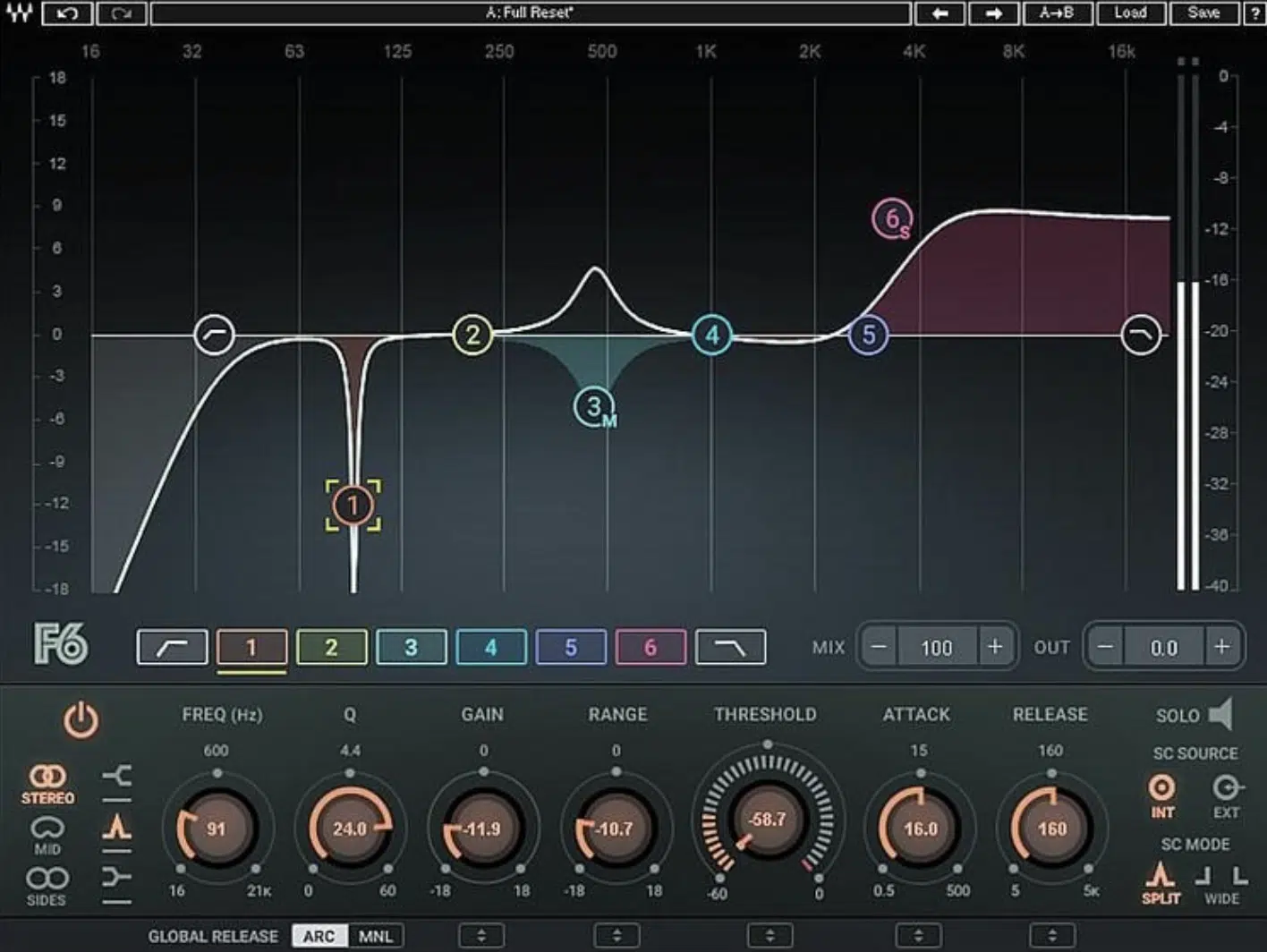
Dynamic EQ is an advanced form of equalization that adapts to the audio signal it processes.
Unlike a static EQ, which applies a fixed amount of gain or attenuation across specific frequency bands, dynamic EQ changes its parameters based on the incoming signal.
This adaptability allows for more nuanced and responsive adjustments to your mix.
It operates by linking the gain of an EQ band to the level of the signal.
This means that changes in gain only occur when certain thresholds are met 一 allowing for a more organic and musical treatment of frequencies.
Whether taming harshness in the high-end or managing low-end rumble, dynamic EQ offers a level of control that static EQs can’t match.
-
The Basics of Dynamic EQ Workings
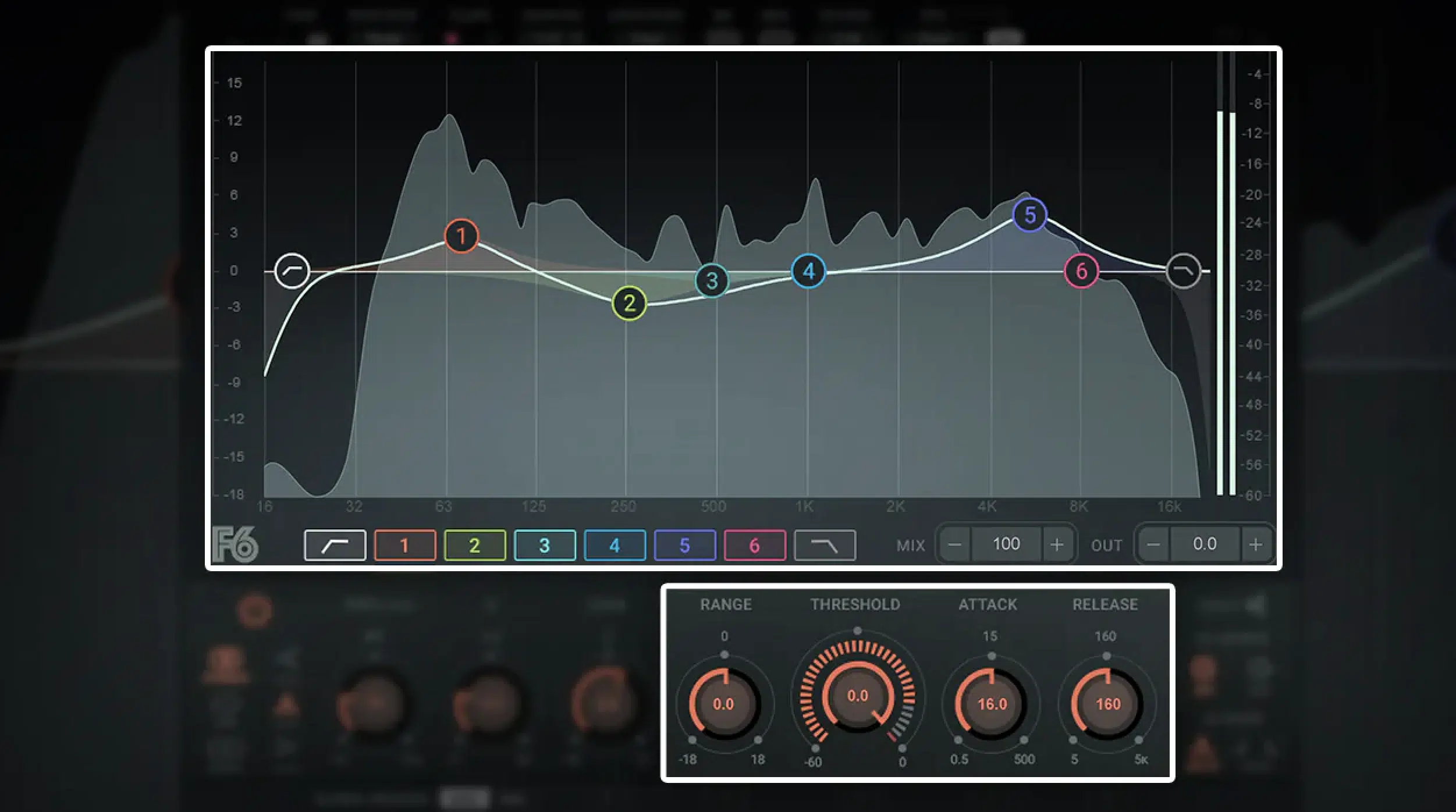
Understanding how dynamic EQ works is key to mastering it.
At its foundation, it combines elements of an equalizer and a compressor.
Each EQ band in a dynamic EQ can act independently, responding to the incoming signal based on set parameters such as:
- Threshold
- Attack
- Release
- Gain
The threshold parameter determines the level at which the dynamic EQ starts to act.
When the signal exceeds this threshold, the EQ band will either boost or attenuate the frequencies based on the settings.
This targeted approach means you can focus on problem frequencies without affecting the rest of the frequency spectrum.
Dynamic EQ vs Traditional EQ
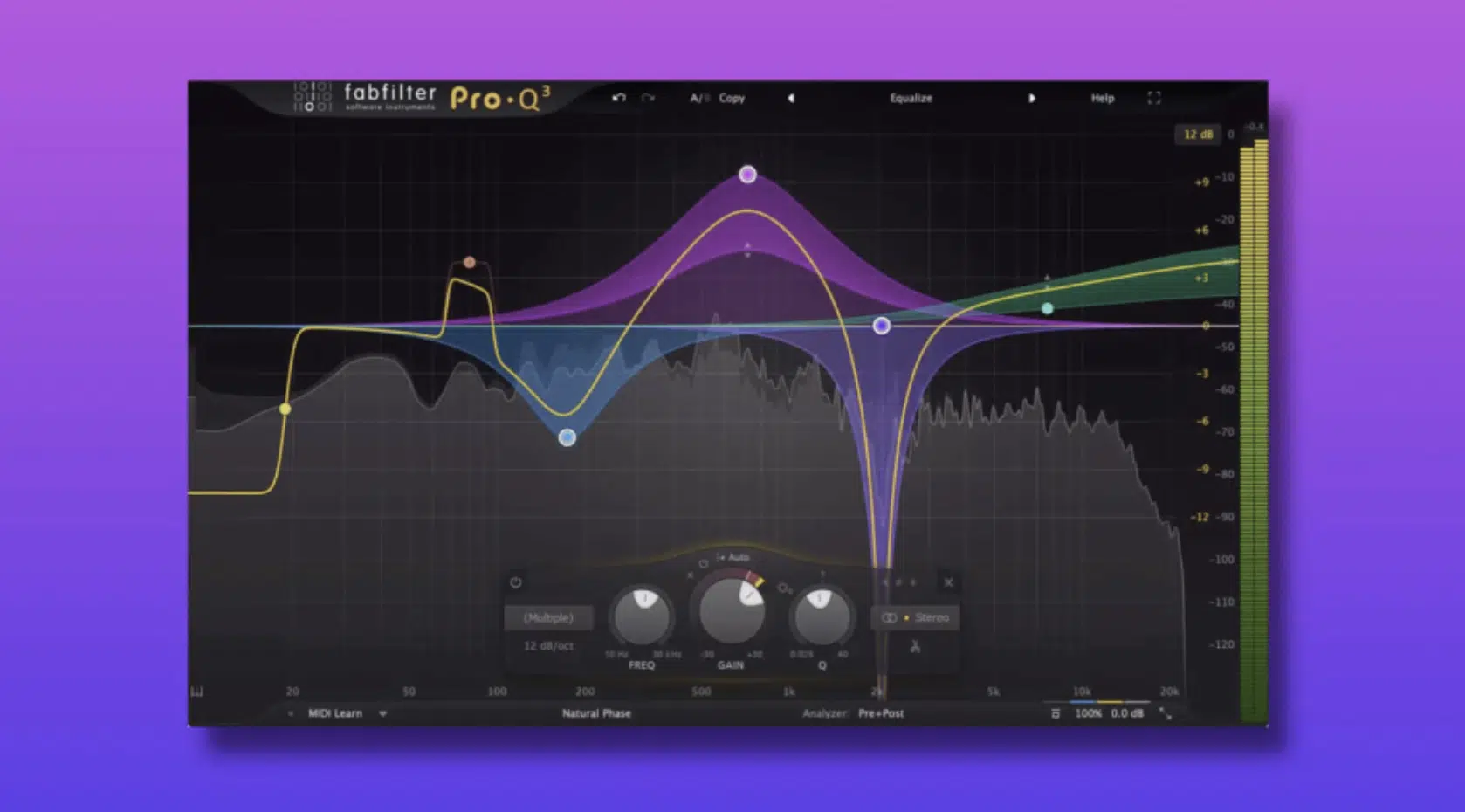
Comparing dynamic EQ to traditional EQ highlights the limitations of static equalizers.
Let’s break down the key differences so you can use each appropriately.
-
Traditional EQ
A traditional EQ, analog or digital, applies a constant boost or cut to chosen frequencies.
This can be useful for shaping the overall tone but lacks the flexibility to respond to varying dynamics within a track.
-
Dynamic EQ
Dynamic EQs, on the other hand, respond in real time to the audio signal.
For example, if a particular frequency range becomes too prominent at higher volumes, dynamic EQ can automatically reduce its level.
This is something a traditional EQ cannot achieve.
A more dynamic approach is just what you’ll need in complex mixes where certain frequencies interact and change over time.
Key Features of Dynamic EQ
Dynamic EQs offer a range of features that set them apart from traditional processing tools. Let’s explore some key aspects making them versatile and indispensable in music production.
-
The Frequency Spectrum
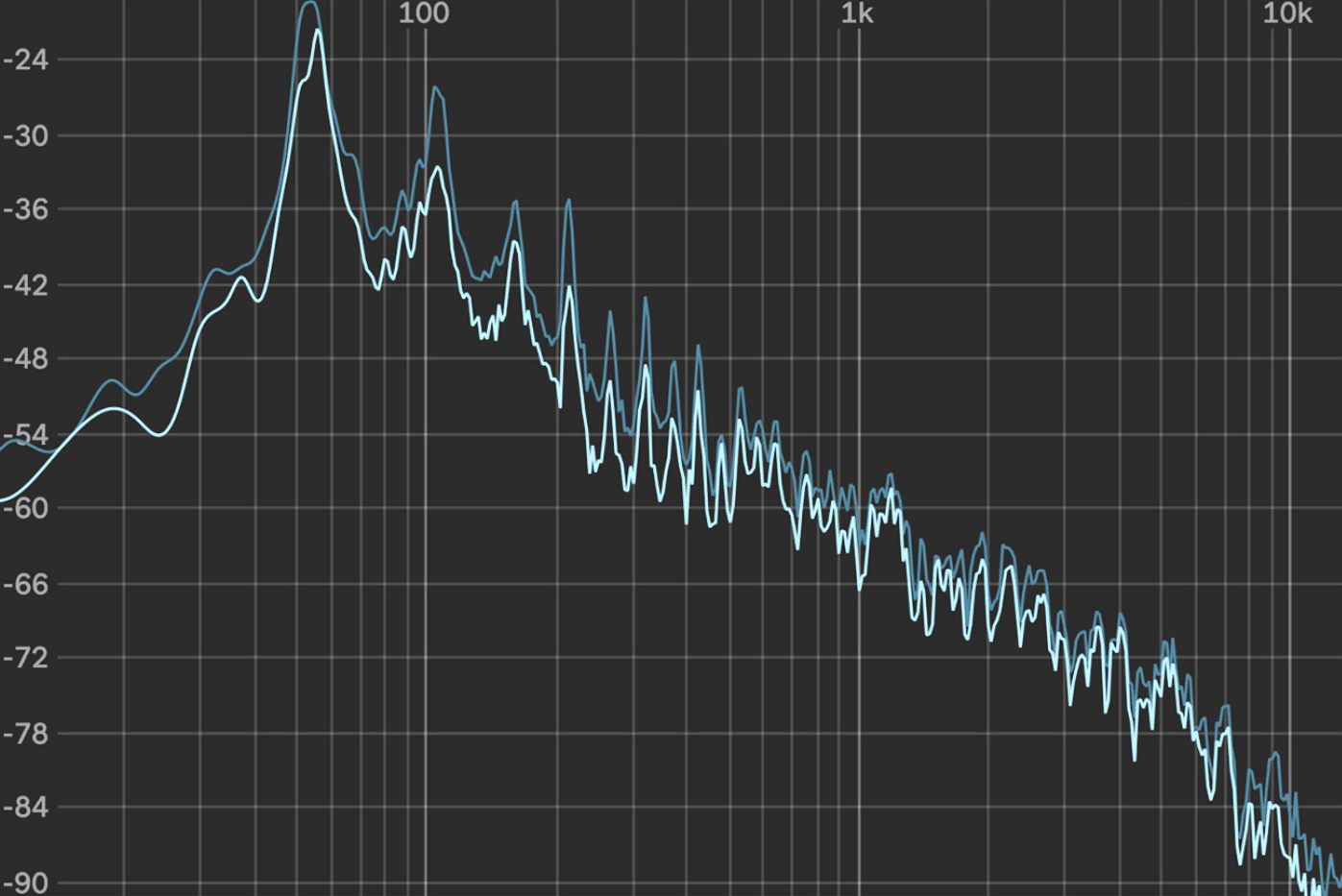
Dynamic EQs excel at manipulating the frequency spectrum of an audio signal with precision.
Each band can target specific frequencies, dynamically adjusting its response based on the characteristics of the signal.
NOTE: This is particularly useful for handling frequencies that vary in intensity or become problematic only at certain times in a mix.
For instance, you can use it to control a bass guitar’s low-end energy or the entire vocal track’s harshness without affecting other parts of the frequency spectrum.
This selective processing ensures that adjustments are made only when necessary, maintaining the natural quality of the original sound.
-
Onset Detection

Onset detection is a critical feature of dynamic equalizers, enabling them to respond accurately to transient information in the audio signal.
This capability allows them to act more musically, adjusting their response based on the timing and dynamics of the incoming signal.
Effective onset detection enables a dynamic EQ to distinguish between:
- Short, transient spikes
- Longer, sustained tones
This discernment is crucial for tasks like reducing the impact of plosive sounds in vocal recordings or managing the attack of percussive elements.
All without affecting the sustain and body of the sound.
-
How To Use Dynamic EQ for Different Frequency Bands
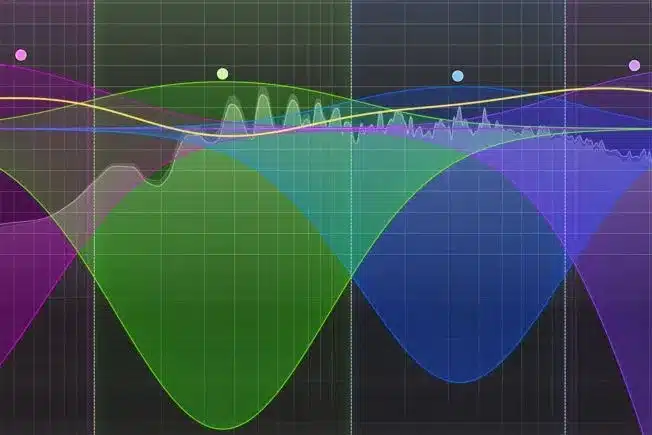
Dynamic EQs provide the flexibility to target different frequency bands with specific settings.
This is particularly beneficial when dealing with complex sources like a full mix or a multi-instrument arrangement.
By setting different thresholds and response curves for each band, dynamic EQ allows for detailed sculpting of the audio spectrum.
For example, you might use it to apply gentle compression to the midrange frequencies of a mix while simultaneously cutting the low-end under certain conditions.
This dual-action capability ensures that each part of the frequency spectrum is treated appropriately based on the needs of the material.
Mixing Scenarios

Dynamic EQ shines in various mixing scenarios, offering solutions that traditional EQs and compressors can’t match.
In the context of a full mix, it allows for subtle adjustments that can make a significant difference.
For example, using it on a vocal track can help maintain clarity without affecting the tonal balance of the entire mix.
When multiple elements compete for the same frequency space, dynamic equalization can be a lifesaver.
Let’s say you have a bass guitar and a kick drum clashing in the low-end.
Dynamic EQ can be set to attenuate certain bass frequencies when the kick hits 一 creating space in the mix.
This selective, frequency-specific sidechaining is something that traditional EQ and compression techniques struggle to accomplish.
Controlling Problem Frequencies
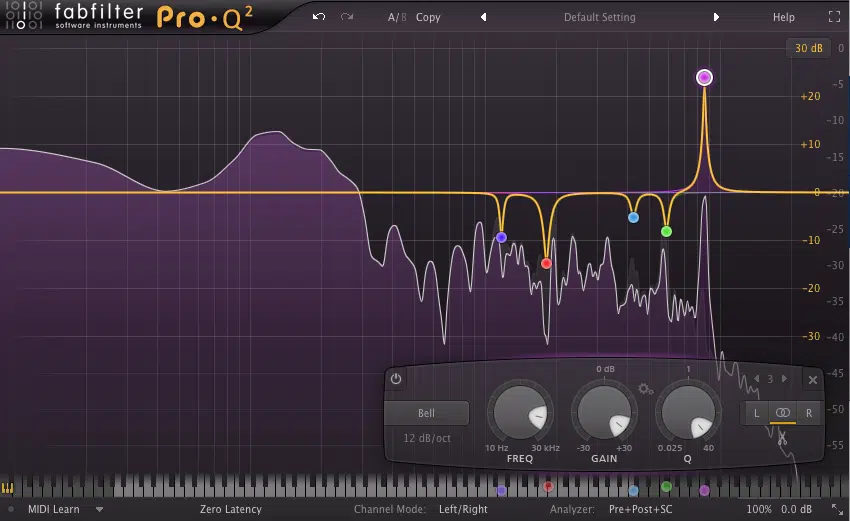
Problem frequencies are an inevitable part of mixing, and this is where dynamic EQ becomes an essential tool.
Whether it’s a resonant peak in a snare drum or a booming frequency in a vocal, dynamic EQ (not to be confused with subtractive EQ) can target and control these issues precisely.
By setting it to react only when the problem frequency becomes prominent, you maintain the natural character of the sound.
It can reduce a harsh sibilance in a vocal track only when it occurs rather than applying a static cut across the entire track.
This targeted approach ensures the vocal retains its natural tone and presence without the over-processed sound that static EQ (or standard EQ) can sometimes introduce.
Dynamic EQ and Multiband Compression
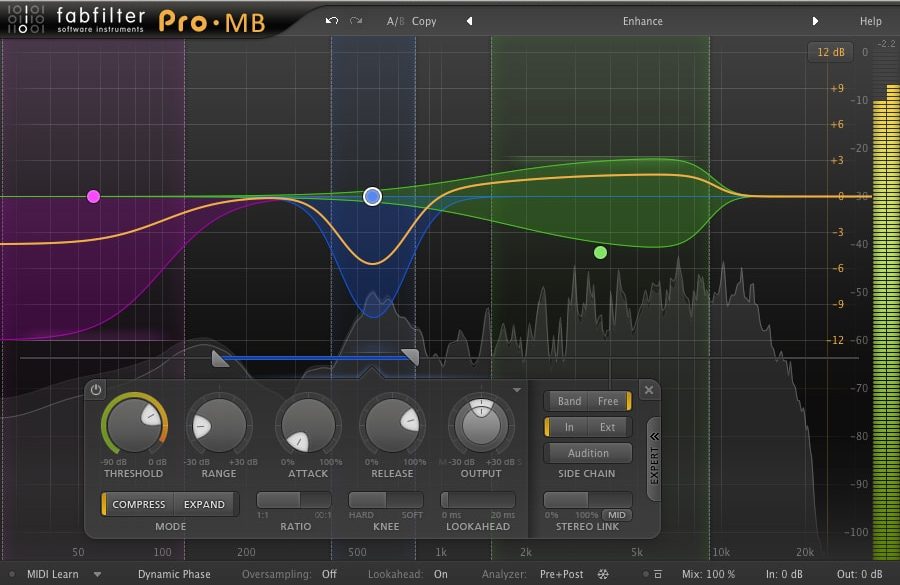
Dynamic EQ and multiband compression are often compared, as both deal with different input signal frequency bands.
However, dynamic EQ offers precision that multiband compressors can’t.
- Multiband compressors 一 Divide the signal into bands and compress each one independently.
- Dynamic EQ 一 Allows for more nuanced adjustments within each band.
One of the key differences lies in how dynamic EQ and multiband compression tools respond to the incoming signal.
A multiband compressor applies compression based on the overall level of the signal within a band.
Dynamic EQ, on the other hand, can respond to specific frequencies within that band.
This makes it particularly effective for dealing with issues that don’t require the broad approach of a compressor.
PRO TIP
When you use dynamic EQ, you’ll discover it’s more transparent than multiband compression.
Since it applies gain changes only when needed, the result is often more natural and less colored.
For instance, it lets you have total control of the low-mids in a mix to prevent muddiness while preserving the warmth and body of the sound.
This is harder to achieve with a multiband compressor.
Enhancing the Low-End
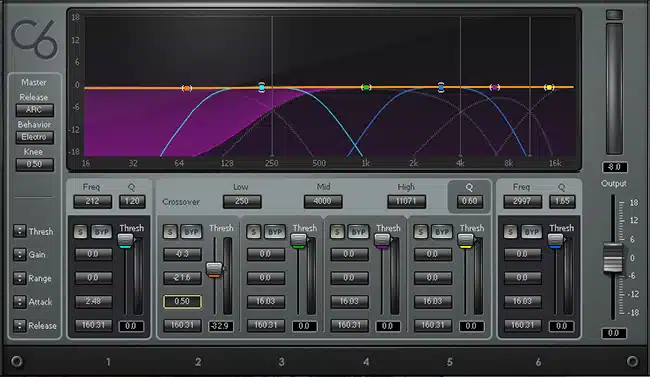
The low-end of a mix is crucial, and dynamic EQ is a powerful tool for managing it.
By using it on elements like the bass guitar and kick drum, you can ensure that these components don’t overwhelm the mix.
Dynamic EQ allows for precise control over the low frequencies, only attenuating or boosting them when necessary.
For example, you can set it to gently reduce the low-end of a bass guitar when it gets too loud 一 preventing it from masking other elements in the mix.
This way, the bass remains complete and powerful without overpowering the mix.
Similarly, it can add punch to a kick drum by dynamically boosting certain low frequencies, enhancing the impact without muddying the overall sound.
Dynamic EQ for Vocals and Instruments
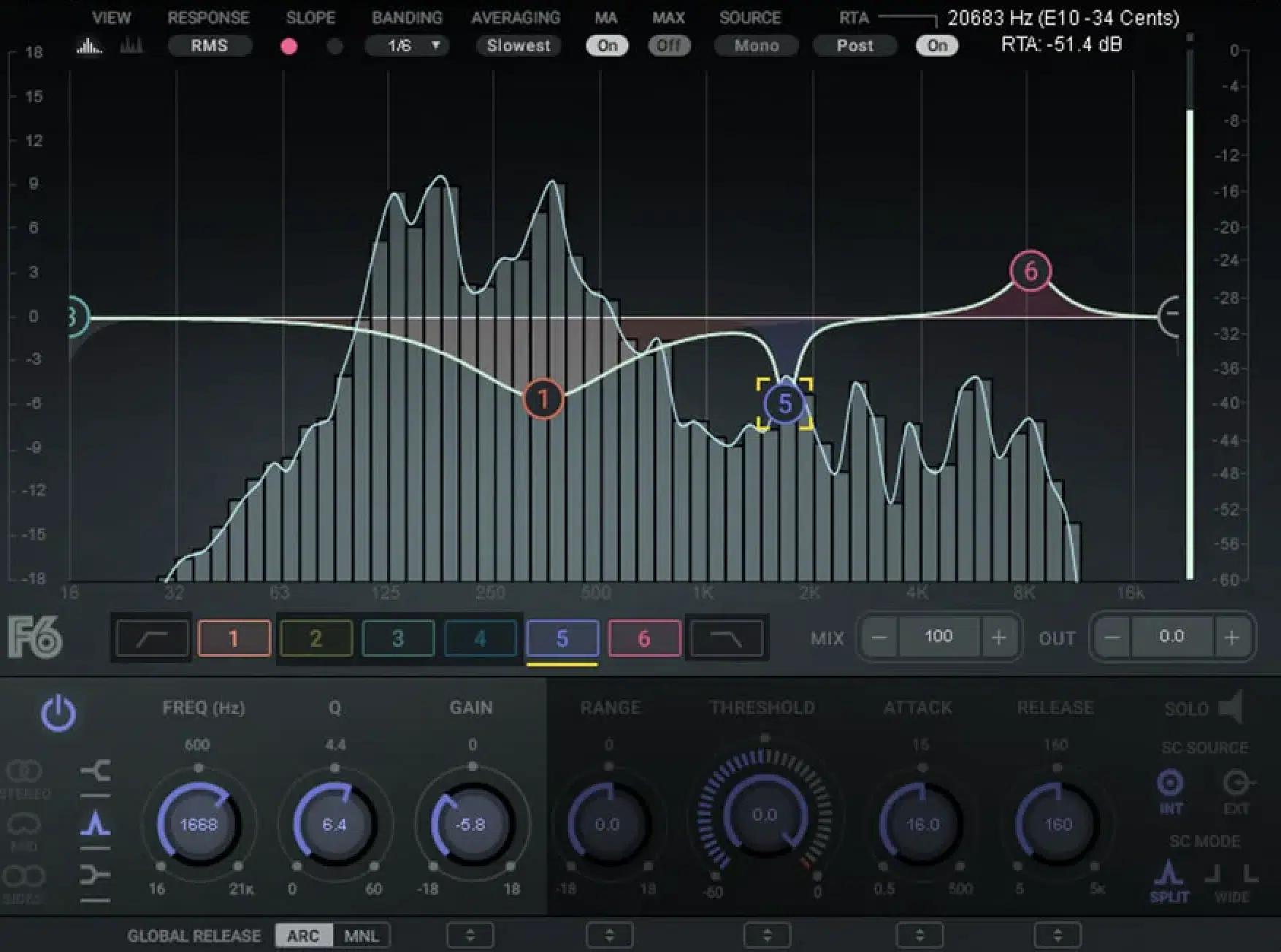
Vocals and instruments often require careful treatment to sit well in a mix, and dynamic EQ is the perfect tool.
For vocals, they can dynamically control sibilance and plosive sounds, ensuring clarity and presence without harshness.
This dynamic processing treatment is far superior to static EQ, which can make vocals appear thin or lifeless, not sound good or enticing.
Instruments like guitars and keyboards also benefit greatly.
By applying it to certain frequency bands, you can:
- Emphasize the character of an instrument.
- Reduce problem frequencies that occur only at certain moments.
For example, a dynamic range EQ can tame harshness in an electric guitar (or rhythm guitar) during loud passages while leaving the tone untouched during softer parts.
NOTE: Applying a static boost to certain frequency ranges, using steep crossover filters for precise separation, and carefully monitoring how the signal passes through these adjustments is vital.
It’s the key to making your mix sound good.
Dynamic EQ Plugins Overview
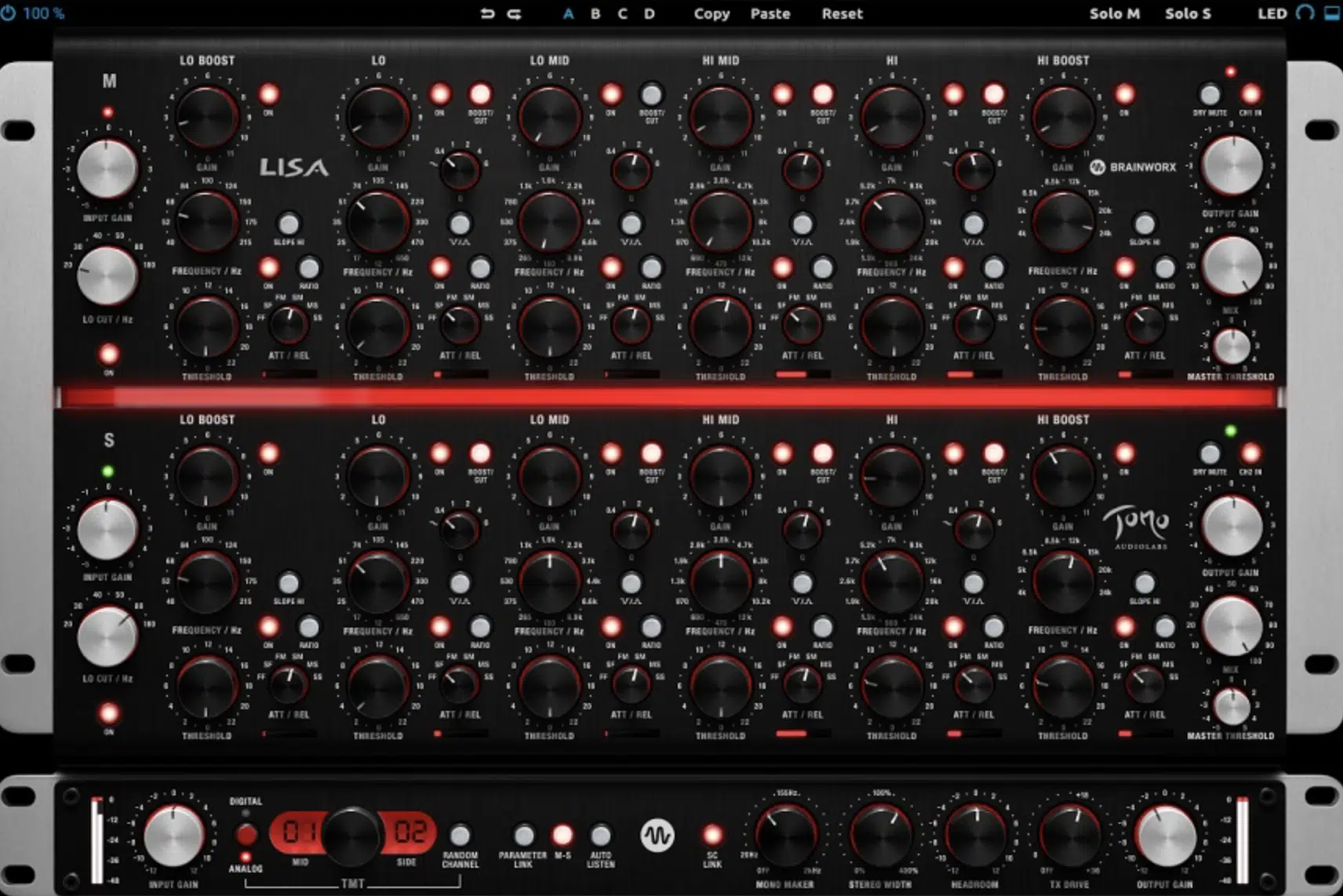
The market is flooded with dynamic EQ plug-ins offering unique features and workflows.
When choosing a dynamic EQ plug-in, it’s important to consider the:
- User interface
- Number of bands available
- Level of control each band offers
One plug-in might be designed for surgical precision, while another plug-in prioritizes ease of use and musicality.
For instance, some dynamic EQ plug-ins offer advanced features like mid/side processing or triggering the EQ bands using an external sidechain input.
These features can be invaluable in complex mixing scenarios where traditional stereo processing isn’t enough.
Additionally, the filters’ quality and the processing’s transparency are crucial factors to consider.
PRO TIP
Dynamic EQs are generally more precise, allowing for targeted adjustments at specific frequencies 一 while multiband compressors are better suited for broader control over the dynamics of different frequency bands.
Advanced Techniques with Dynamic EQ
Moving beyond the basics, let’s explore advanced techniques that can elevate your mixing skills, specifically when tackling challenging mixing situations.
-
Sidechain Input
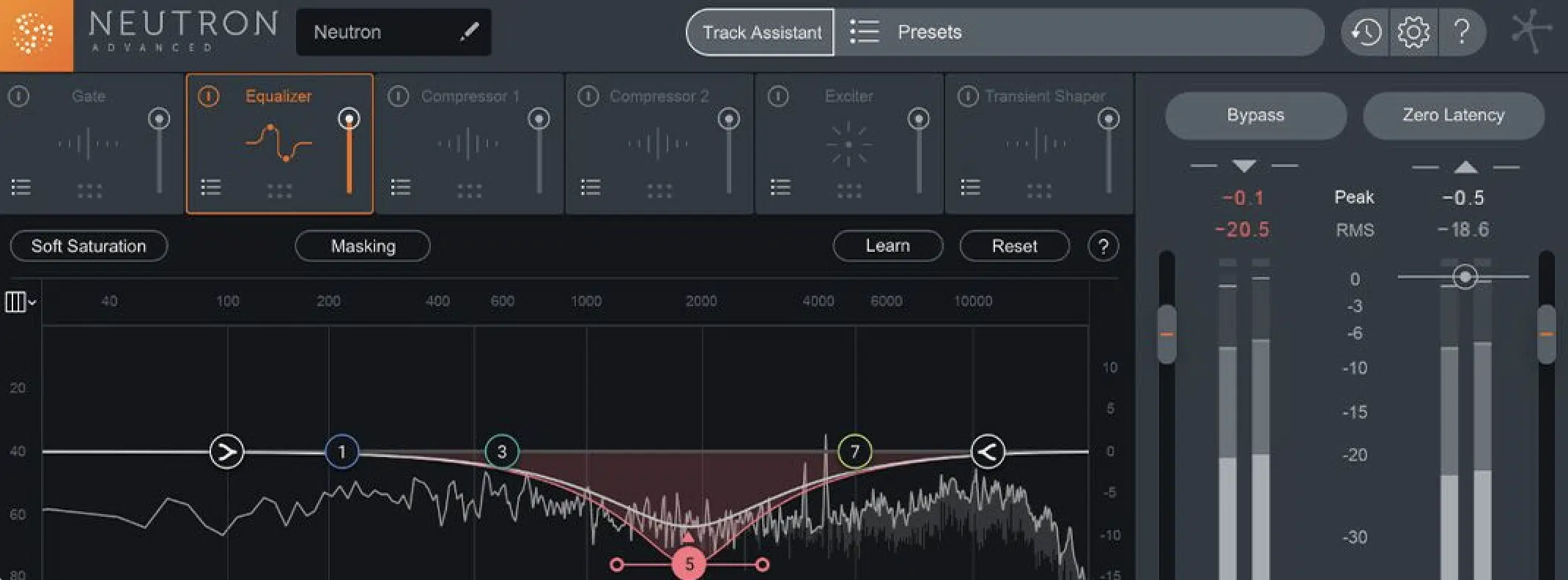
The sidechain input feature in dynamic EQs opens up a world of creative possibilities.
By feeding an external signal into the sidechain of a dynamic equalization, you can make the EQ react to another element in the mix.
This sidechain functionality technique is used for frequency-specific ducking or creating space for essential elements (like vocals or kick drums).
For instance, you can sidechain the bass guitar to the kick drum 一 making the dynamic EQ on the bass reduce certain low frequencies whenever the kick hits.
This creates a pumping effect and ensures that the kick cuts through the mix without being masked by the bass.
This level of control is much more precise than what you can achieve with traditional sidechain compression (not to be confused with downward compression).
-
Dealing with Resonant Frequencies
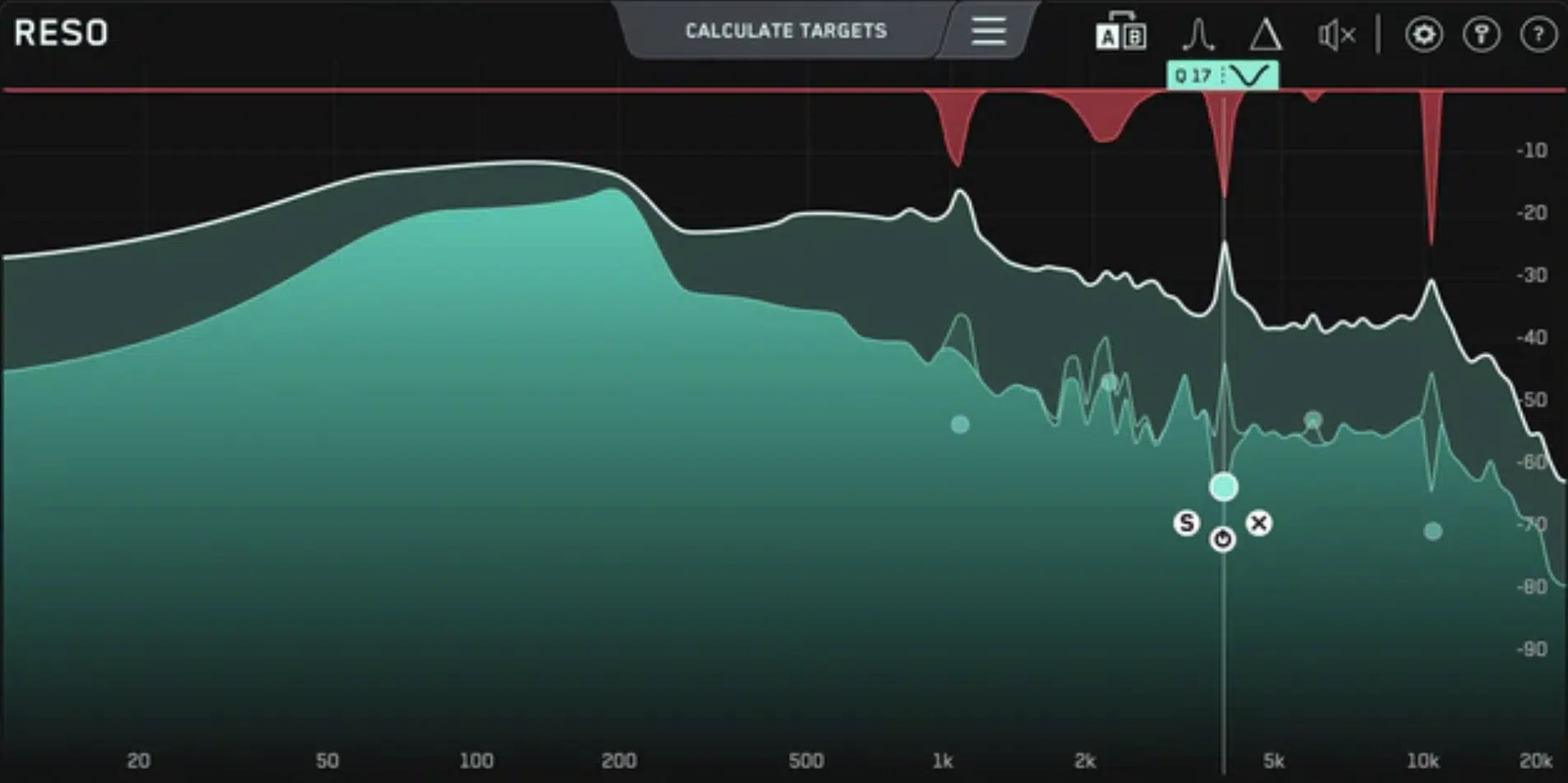
Resonant frequencies can be problematic in both recording and mixing.
Dynamic equalization is an excellent tool for handling these issues without overly dampening the overall sound.
By setting it to target the specific resonant frequency, you can attenuate it only when it becomes problematic 一 preserving the integrity of the original sound.
This technique benefits acoustic instruments like an acoustic guitar or piano, where certain notes might resonate more.
Applying dynamic EQ allows these resonant peaks to be controlled.
This results in a more balanced and pleasing sound without the artifacts that static EQ might introduce.
-
Advanced Gain Control Techniques
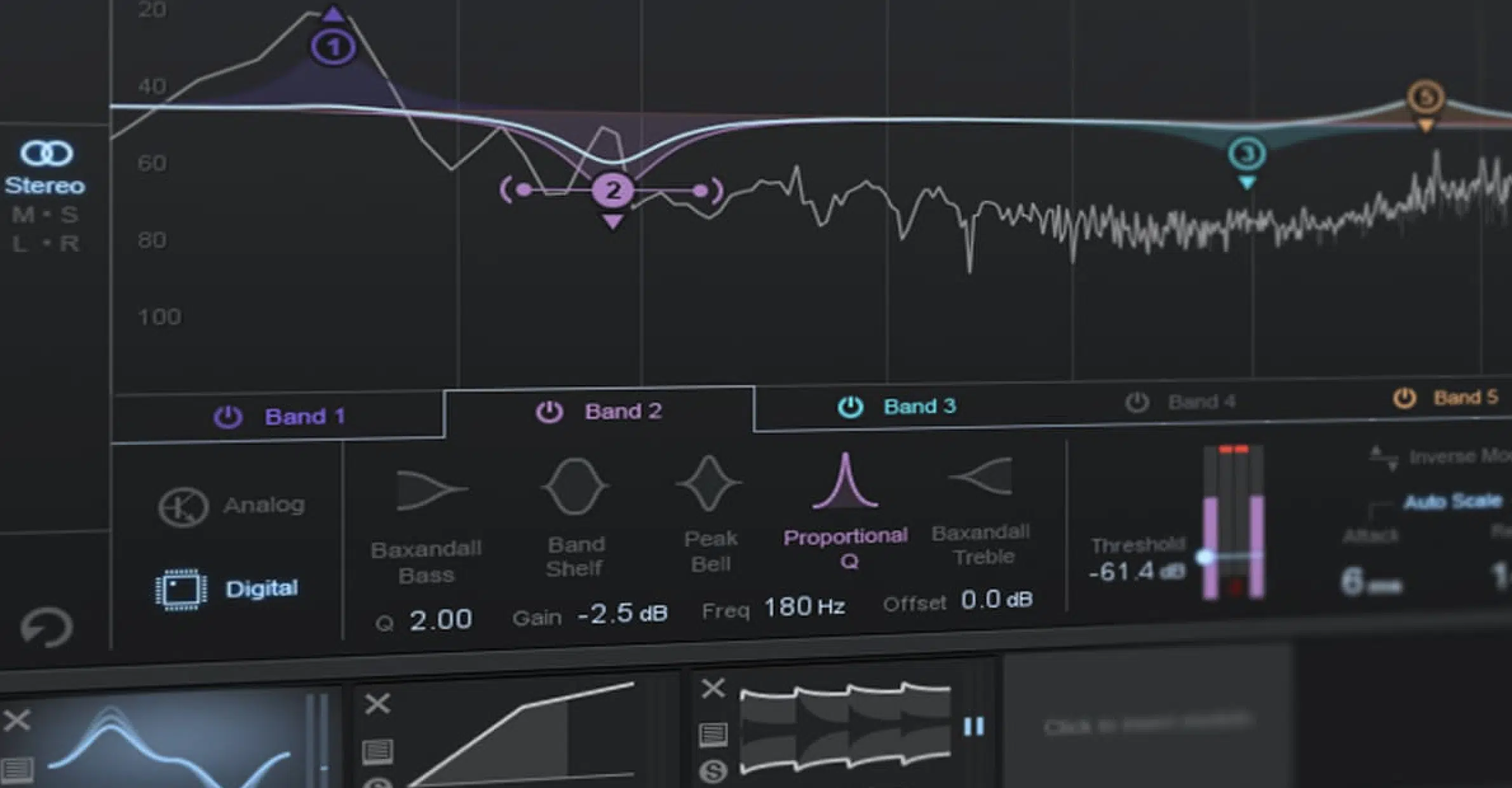
Advanced gain control is another area where this processor excels.
Unlike traditional EQs, which apply a fixed amount of gain change, dynamic EQs can vary the gain applied to a frequency band based on the level of the incoming signal.
This enables more refined and adaptive adjustments, crucial for dynamic and complex audio material.
For example, in a mix where the vocal’s brightness fluctuates, a dynamic EQ can only boost the higher frequencies when they fall below a certain level.
It ensures consistent clarity throughout the performance.
This approach is much more fluid and natural than static EQ boosts or cuts, which can affect the tonal balance of the entire track.
-
Frequency Band Optimization
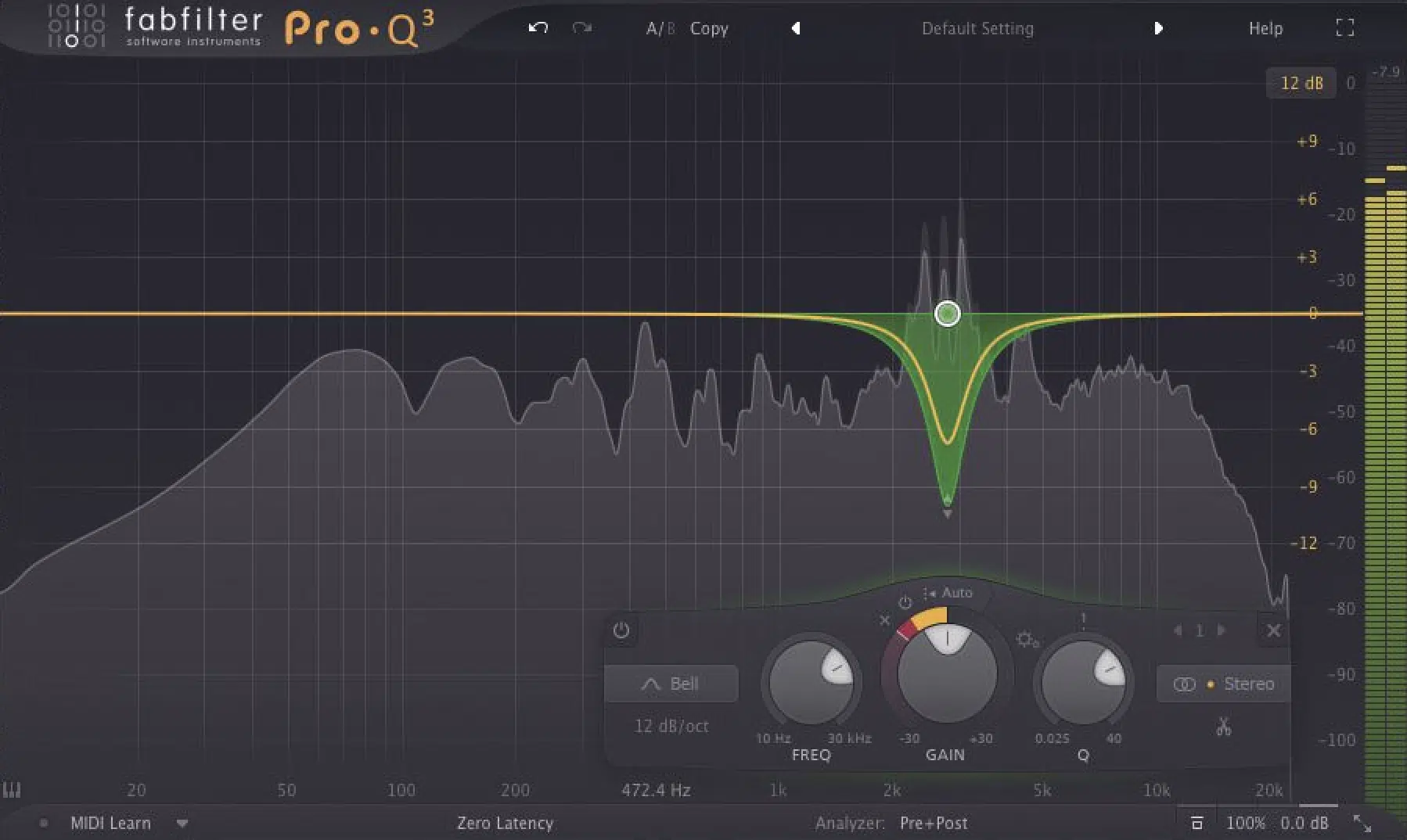
Optimizing frequency bands with dynamic equalization can significantly enhance the clarity and balance of a mix.
It involves carefully setting the threshold, ratio, attack, and release controls for each band to respond appropriately to the signal’s dynamics.
This fine-tuning ensures that each frequency band (the frequency content) is processed only when needed 一 maintaining the natural character of the audio.
For instance, you can set a tighter Q (quality factor) on a dynamic EQ band to target a specific problem frequency in a vocal track.
Adjusting the threshold and gain parameters ensures that the EQ only engages when that frequency becomes too prominent.
Therefore avoiding unnecessary alteration of the rest of the vocal’s frequency spectrum.
Bonus: How to Use Dynamic EQ in Different Music Production Software
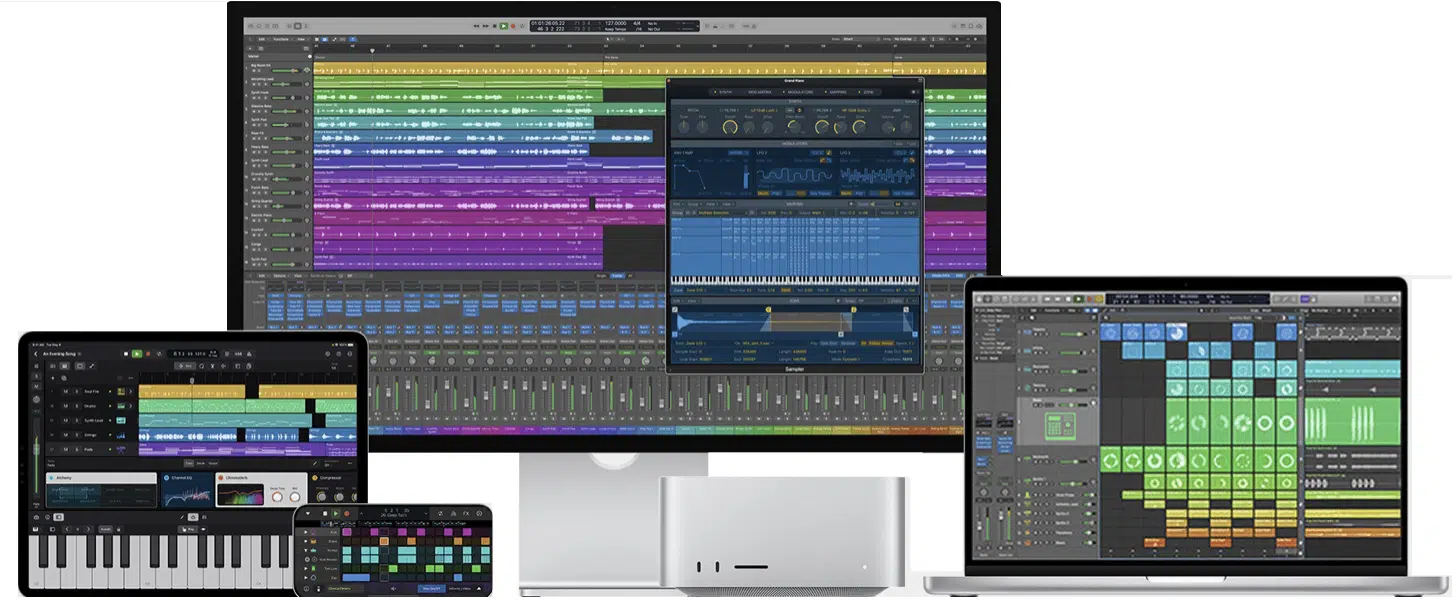
The versatility of dynamic equalization extends to its use in various music production software platforms.
Whether you’re working in Pro Tools, Logic Pro, or any other DAW, the principles of dynamic EQ apply universally.
However, each software might offer unique features or workflows (or an intuitive user interface) to enhance your experience with other dynamic EQ processes.
For example, in Logic Pro, you might find that the integrated equalization options seamlessly integrate with the existing mixing environment.
It offers intuitive controls and visual feedback, like a spectrum analyzer.
On the other hand, Pro Tools users might prefer third-party dynamic EQ plugins for their advanced features and flexibility.
The key is understanding how dynamic equalization functions within your preferred DAW and leveraging its capabilities to suit your mixing style.
Dynamic EQ: Final Thoughts
Dynamic EQ, as you now know, is a powerhouse in the music production world.
It can help you seamlessly manage frequencies, create space in your mix, and ensure every element sits perfectly in its place.
Now, armed with this knowledge and tricks, you’ll be able to tackle complex audio issues, bring out the best in your tracks, and shape sounds with precision and creativity, just like a professional.
To further enhance your journey, don’t miss out on the Free Famous Beatmaker Template Essentials.
This collection includes meticulously crafted structures of hit tracks in Ableton, FL Studio, and Logic Pro.
By exploring these templates, you can see and hear how dynamically EQ’d tracks sound 一 providing you with a gold standard to aim for in your own mixes.
Each template embodies the structures of hit tracks, allowing you to inject your unique style.
Feel free to tweak, customize, and truly make each template your own.
This will unleash your full creative potential and taking your production skills to new heights.
Until next time…







Leave a Reply
You must belogged in to post a comment.